Monday, August 31, 2009
Super-Deformed Medieval Dudes
Mark Greenwalt, The Gods of War, graphite, red chalk, acryilic on panel, 2008
He includes a tiny self-portrait in this piece. It looks incongruously contemporary among all these deformed medievel figures.
Mark Greenwalt, The Gods of War detail, graphite, red chalk, acryilic on panel, 2008
I'm afraid my photos don't really capture the subtlety of his drawing. (For decades now, painting has been biased by what art would reproduce well in magazines. Perhaps now, good reproduction online will give artworks an extra boost. Too bad for artists like Greenwalt...)
Mark Greenwalt, Innocence, Death, Wisdom, graphite, red chalk, acrylic on panel, 2008
I really like his work. I think these pieces demand contemplation. Certainly they reward looking very close at the surface and checking out the details.
One more thing about the O'Kane. I realize the student who works there is your average work-study employee. I was one once. But I have two suggestions for her. 1) Pretend like you get and more important like the art, even if you don't. Memorize some facts about the artists you can recite when you have visitors. 2) Don't dress like a student. Torn jeans and tee-shirts show a lack of respect for the art and the patrons. Try to look more artsy-yet-professional. Not like you just did an all-nighter writing a paper. Just saying.
The Kandy-Kolored Geometries of Jonathan Leach

This photo was lifted off the gallery's website. It gives the impression that Leach paints in pastel colors, but the reality is that these works are quite vivid.
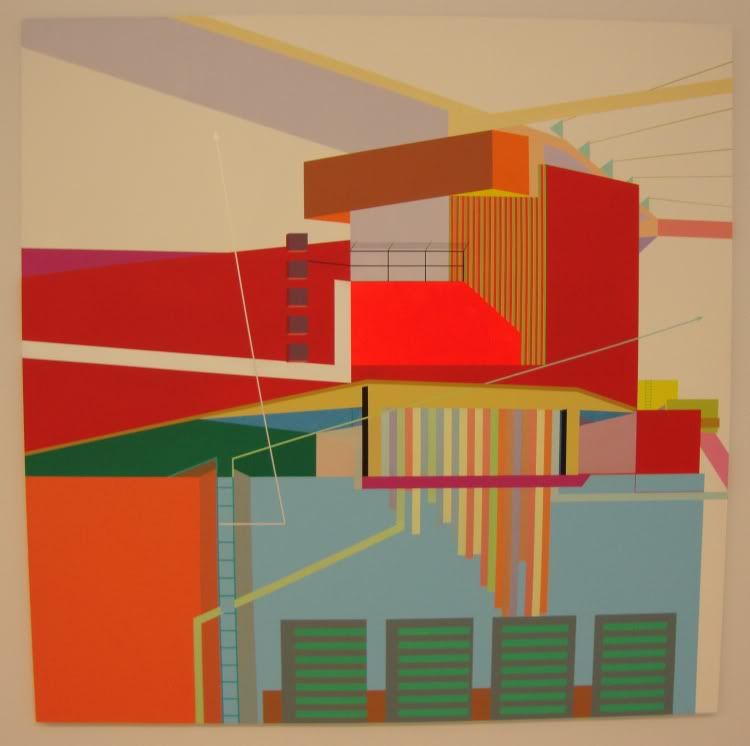
I took this one, which I think represents the range of value better, but still doesn't give you an idea of the intensity.
These two paintings are the most "architectural" of the work--the other pieces are more abstract, and a few are what I would call minimal. They are worth seeing in the flesh if you like hard-edge abstraction (which I, for one, do).
My Favorite Bits of Lawndale's 30th Anniversary Show
The great James Surls spoke about the founding of Lawndale last week. The show that is up now doesn't try to encapsulate Lawndale's entire 30-year history. It is composed of work by six artists who have all shown at Lawndale within the last five years.

Elaine Bradford, Harry With Worlds on Top, taxidermy elk's head, crocheted yarn, 2009
Elaine Bradford has been a high-profile artist in Houston. (Readers might recall that I bought a photograph of hers earlier this year.) I like the piece above because in it I see strong echoes of Dr. Seuss. I didn't see that in her taxidermy/knitting works before, but now it seems obvious. Bradford is hunting and mounting Seusses.

Elaine Bradford, Little Ram, Tiny World, plastic ram head and crocheted yarn, 2009
Emily Sloan turned the columns in the main space in Lawndale into these giant lamps. (I am assuming these columns were already there--I never really noticed them before.)

Emily Sloan, Boudoir Lamps in Black, Red and Gold, four structural columns with fabric, steel, wood and paint, 2009
I have no idea what she is saying with these "lamps" but they look cool.

Seth Alverson, Woman Bending Over, oil on canvas, 2009
Seth Alversons paintings are admirable but cringe-inducing (at least the ones I'm reproducing here). I don't really want to look at that lovingly-painted cottage cheese, but can't look away. He should hope a museum gets it, because it's hard to imagine a collector hanging this on her wall.

Seth Alverson, Tits in a Window, oil on canvas, 2009
Or this (these?)!

Mark Schatz, A Map Drawn from Memory, Torn to Pieces and Thrown into the Sea, mixed media, 2009.
Little bits of landscape, looking like a cross between Google maps satelite view and a model railroad diorama, with huge iceberg-like chunks of stone beneath them, hung upside down. The inherently creative impulse of model railroaders, plastic model builders, and diorama-makers of all stripes is art-schooled here. I approve. I've loved dioramas since I was a little kid. Here's a closer view:

Mark Schatz, A Map Drawn from Memory detail, Torn to Pieces and Thrown into the Sea, mixed media, 2009.
There are other good pieces in the show by other artists. But these were my favorites. Lawndale may not be the wild, crazy, unafraid-to-fail, anarchic place it was when James Surls started it, but it puts on a good show.
Sunday, August 30, 2009
Jason Villegas / The Art Guys at the McClain Gallery
So I went to McClain Gallery with a different approach. I would ask for permission to take photos. I even made up business cards for this blog, to try to give a little legitimacy to my request. And I was prepared to get a "no." That would have been fine. But the reaction I got was weird. The fellow I talked to (McClain?) was indifferent to whether I took photos. But he was worried that I would write something controversial. This was a commercial gallery that existed to sell art--not to create controversy. I assured him that I had no intention of being controversial (kind of an empty promise because I have no idea what he would consider controversial). That ended my experiment with asking permission; in other galleries, I just whipped out the camera, hoping not to be kicked out. Still, given McClain dude's conditional permission, I snapped away.
The show in the front gallery is work by Jason Villegas, who also has a show up at the CAMH. You can't ask for better advertising than that (or, as Don Thompson writes The $12 Million Stuffed Shark, CAMH enhances Villegas' brand in the eyes of local collectors). Villegas does his own version of crap on crap. For him, the crap consists of old golf shirts found in thrift stores, particularly ones that had little animals on them. Obviously the famous brand is the Izod alligator, but it turns out that there were (are?) lots of animal knock-offs.
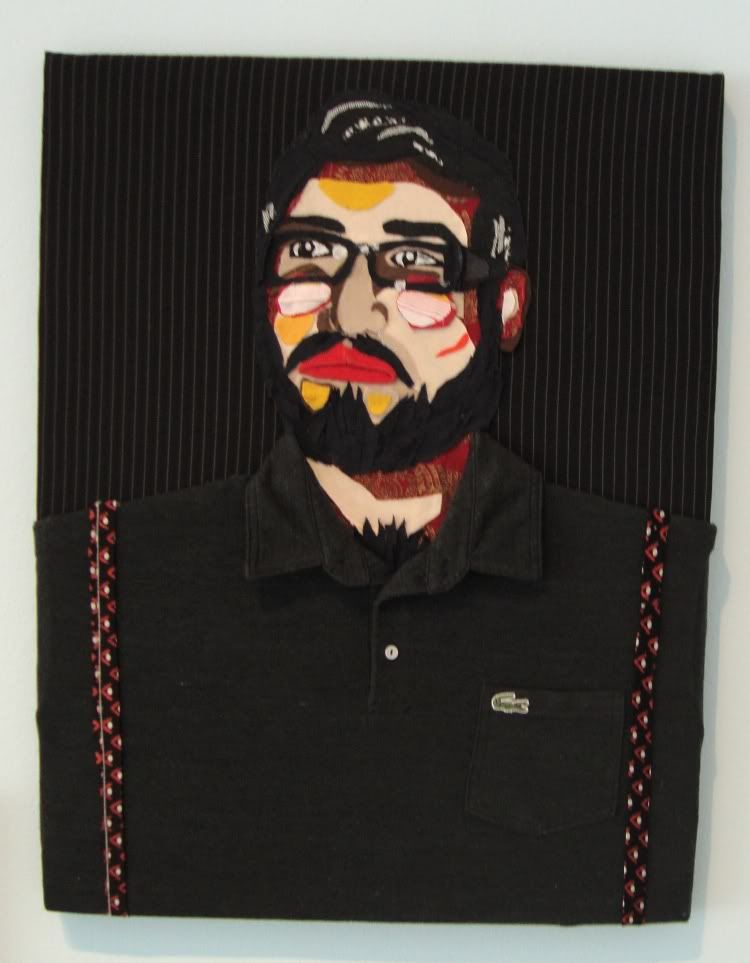
Conquistador, Jason Villegas, 2009
He approaches the work of tearing up and recombining golf shirts from every angle, including paintings of the assemblages. One of the pieces at CAMH consists of horizontal ripped pieces of shirts stapled to the wall in the shape of a rounded triangle. The shirt bits all have long thin curled up bits of fabric hanging down like fringe. So here at McClain, Villegas basically paints this assemblage. Twice.
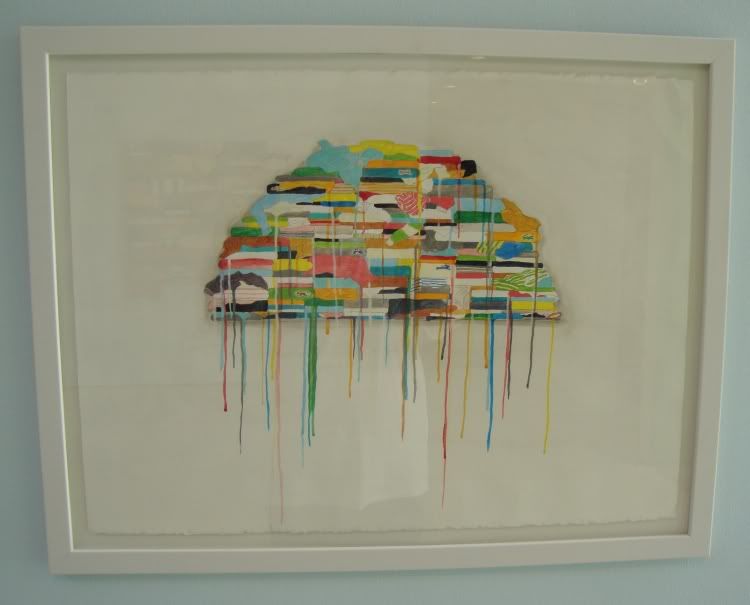
Polo Pile, Jason Villegas, acrylic and marker, 2009
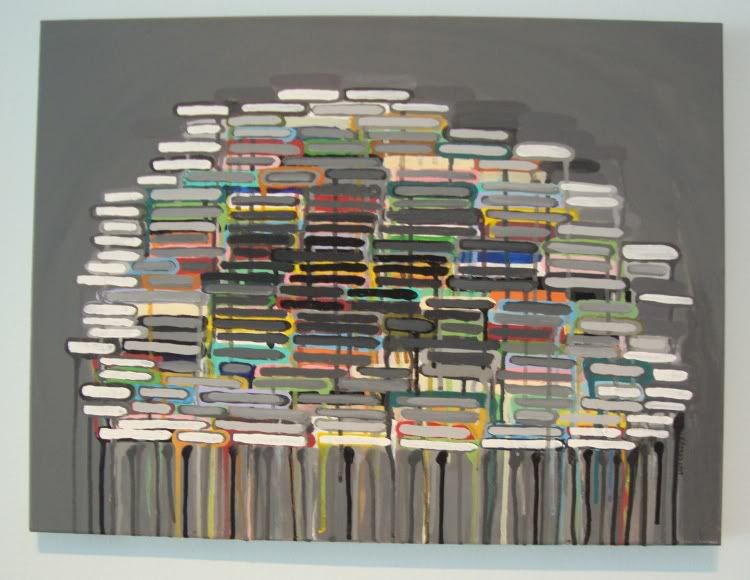
Polo Pile Subdued as Microorganism, Jason Villegas, acrylic, 2009
The hanging fringe of the original is replaced by paint drips in these versions.
He also creates self-portraits where he takes on the animal identity of each brand.
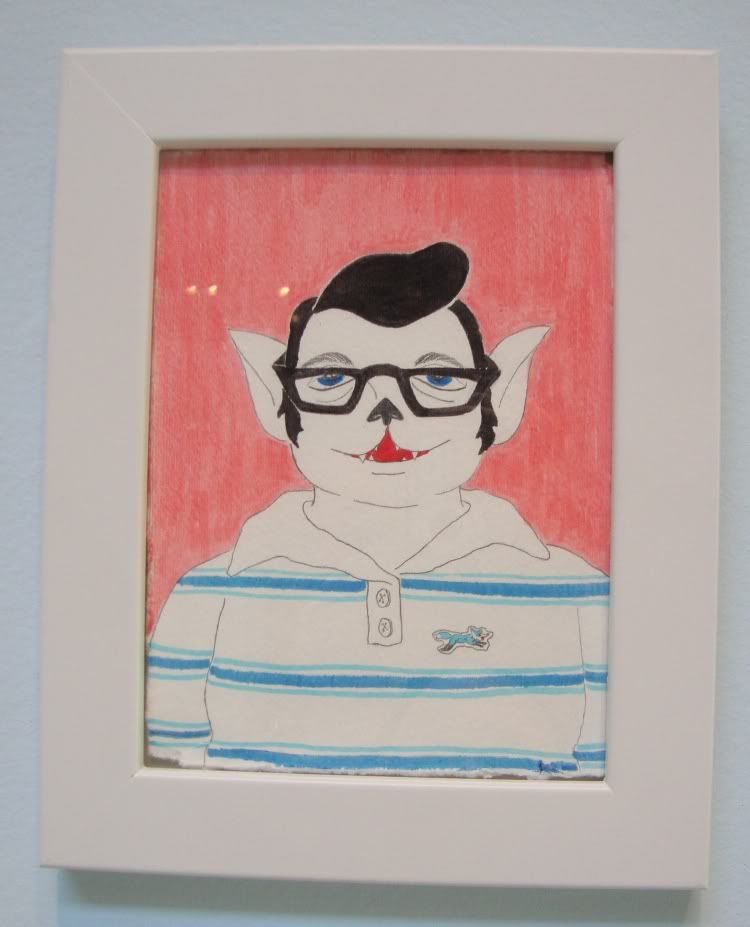
Self-Portrait as Fox Brand, Jason Villegas, marker and pencil, 2009
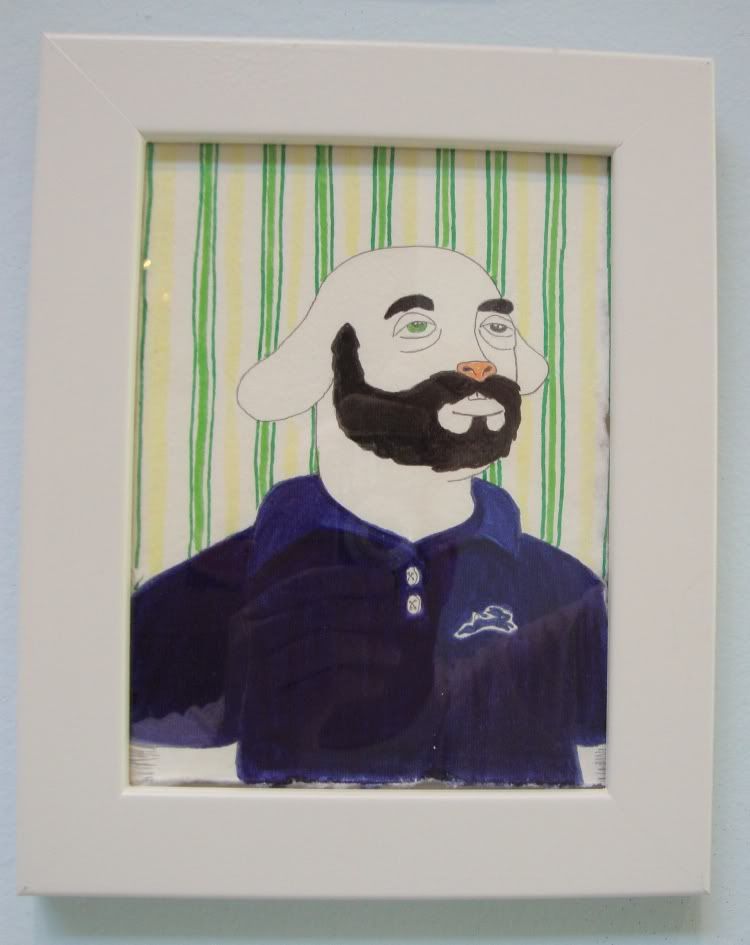
Self-Portrait as Hare Brand, Jason Villegas, marker and pencil, 2009
The biggest piece was drawn and stapled right to the rear wall of the gallery.
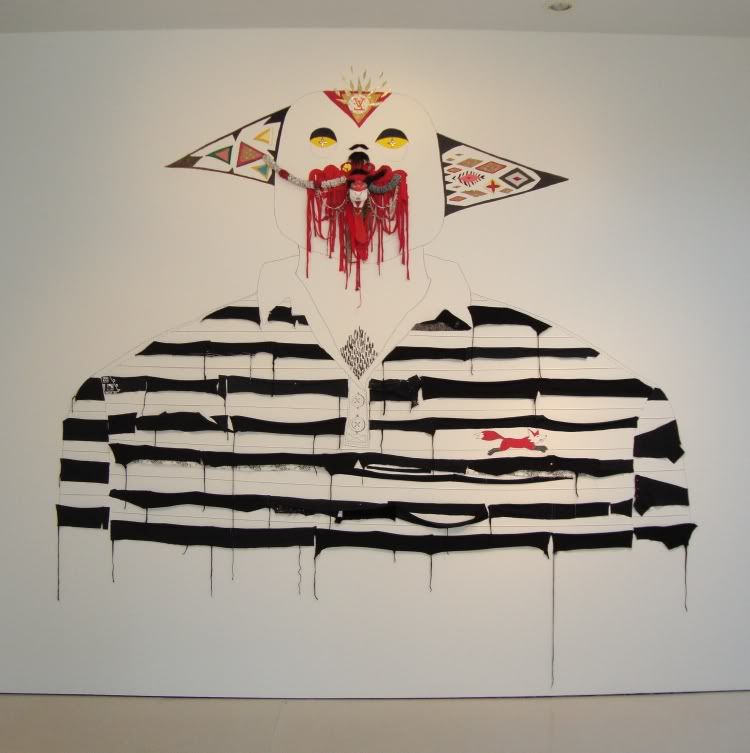
Fox Brand Spirit Portrait, Jason Villegas, mixed media installation, 2009

Fox Brand Spirit Portrait detail, Jason Villegas, mixed media installation, 2009
As you can see, the little fox appears to be drawn right on the wall. (Or maybe drawn on paper and pasted.) As the man I spoke with repeated emphasized, the McClain Gallery is a commercial enterprise. All these works are for sale; all of them have prices on a price list. Except this one, which is POR (price on request).
So what do you get if you buy "Fox Brand Spirit Portrait"? Does Jason Villegas come over to your house and staple the bits of torn golf shirt right on your wall? Does he draw a little fox on your plaster? I have often wondered this about installations that are sold through commercial galleries.
In a gallery in the back is a small show by The Art Guys. Whenever I see their work, I just dig their endless inventiveness and humor.
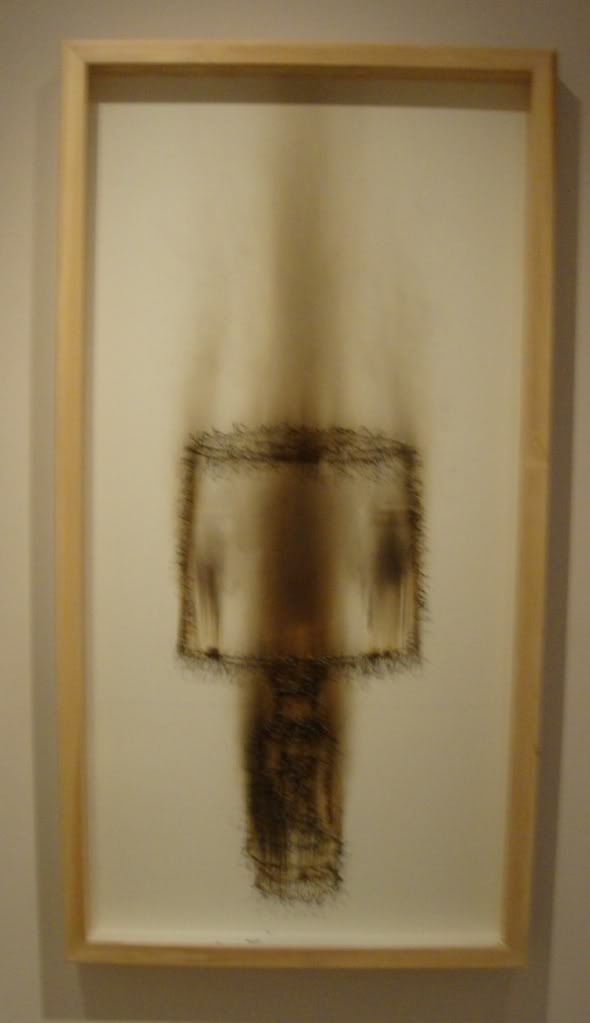
Lamp, the Art Guys, burned matches on paper, 2008
Burned matches? Yep. Here's a detail.
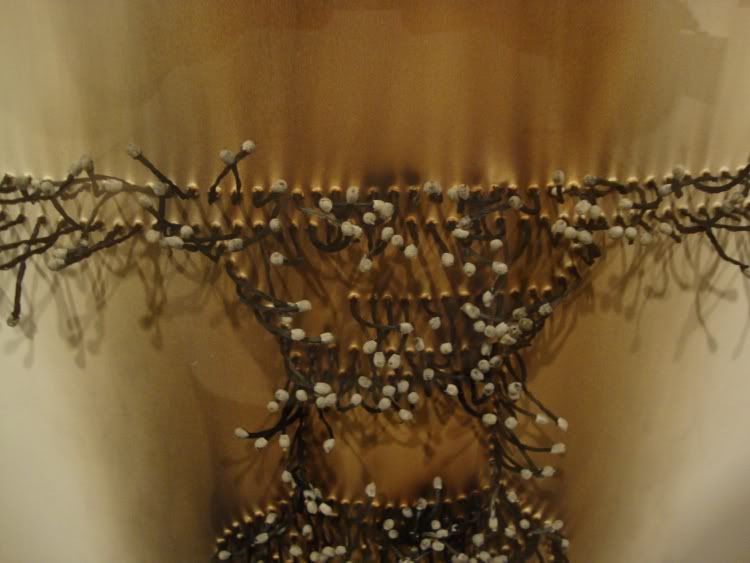
Lamp detail, the Art Guys, burned matches on paper, 2008
But here's my favorite piece in the show. I apologize for the poor photograph. I have done all kinds of digital manipulations to make it a little more readible.
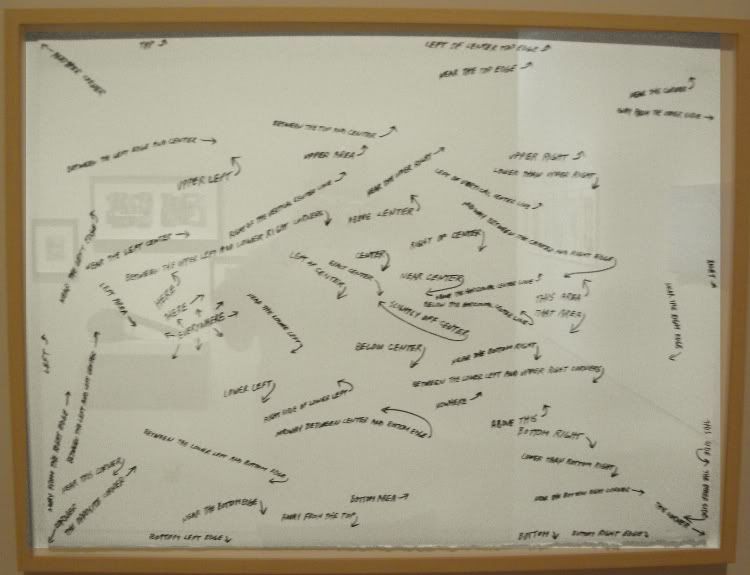
Any of These Locations Would be an Excellent Place to Begin a Drawing, the Art Guys, graphite on paper, 2008
It's hard to read, but the little phrases in this piece say things like "Left of center", "Exact center", "Slightly off-center", "Near the bottom", etc. That piece should go in a drawing textbook.
Impressions of the gallery? Very high-end commercial (although I should add that you could buy some of those Jason Villegas pieces for really decent prices). You look at the artists McClain shows, and they are almost all fairly well-known contemporary figures. In The $12 Million Dollar Stuffed Shark, Don Thompson speaks of how big New York and London galleries will have subsidiary relationships with galleries in other parts of the country, so that non-NYC galleries can market some of the big names from NYC to the hinterland. So I wonder if McClain has that kind of relationship with any blue chip galleries in NYC. Such an arrangement, I assume, would mutually benefit the artist (geographically expanding his market), local collectors (improved access to top artists' work), the local gallery (ability to show top NYC artists), and the New York gallery (improved access to non-NYC collectors). But I wonder how the contracts between the local gallery and the NYC gallery work? Of course, I have no idea if this is what McClain is doing in the first place, so please excuse this idle, completely uncontroversial speculation.
Saturday, August 29, 2009
Combining Crap With Crap
Paddy Johnson, responding to the outcry the original post caused, wrote a new post: "Reasons Why Assemblage (Or 'Crap on Crap') Is Now the 'House Style' of the Art World." In my profound laziness, I am just going to copy her reasons here.
1. Everybody’s broke and there’s always an abundance of trash.I would add at least one more reason. (11) A delight at taking bits of crap and creating something artistically interesting out of it. I guess 11 overlaps with 5, 6, and 9, except I am thinking more of things like Picasso making a bull's head out of a bicycle seat and handlebars.
2. Six years of art education teaches that high art is dead so everyone takes the low road.
3. Disgust with capitalism and consumer culture.
4. “Nihilism.”
5. Genuine love of trash culture and its byproducts.
6. Avoidance of known art materials.
7. A way to make formal arrangements of things without being called “Greenbergian.”
8. A way to be political without sloganeering.
9. Genuine interest in the lineage of Schwitters/Rauschenberg–-considering it an unfinished project.
10. New trash (web and technology cast-offs) necessitates new ways of arranging trash (and new content unknown to Rauschenberg, et al).
.jpg)
Of course, some of my all time favorite artists were or are "crap on crap" artists: Kienholz, Rauschenberg, Jessica Stockholder. And the word "assemblage" just sounds like it was invented by fucking PhD. I will keep using the word, but in my mind, all those great pieces of scrap and glue and stuff are "crap on crap" art.
Friday, August 28, 2009
Once Upon a Time at Lawndale
Last night, I went to hear James Surls speak at Lawndale. Surls was the founder of the institution 30 years ago. Lots of former students and cronies were present, as well as art lovers of all stripes (I saw the director of CAMH there). It was a standing-room only crowd.
Surls is almost 70, but he has the vitality of a much younger man. He speaks and looks like someone decades younger. Just imagine, then, what a dynamo he must have been when Lawndale started.
He's a modest person. He claims it was the right time and right place for Lawndale, and that he was just along for the ride. He refers to the founding of P.S. 1 in New York in 1971, and similar institutions in L.A., and says it was inevitable that something like that would pop up in the middle of the country somewhere. Probably so.
He had been teaching at SMU, and he proposed that they just buy a warehouse for that purpose. He knew they'd say no. So he comes to Houston, an art professor, no particular ambitions to try to get the university to buy a warehouse because, after all, he knew they'd say no--when the art department's building caught fire. It was uninhabitable. Fortunately, UH had another space. Schlumberger had given UH an old building out on Lawndale. The admin at UH was very apologetic about putting him and his students in this industrial tenement in the middle of a slum. Surls was all, "Please don't trow me in dat briar patch, boss!"
Of course it turned out to be perfect. Huge exhibition and performance spaces, studio space for many, many students (and random fringies). Surls described it as "indestructible."
And it was needed really badly at that moment. The major art institutions in the city had no interest in showing local art. (This was before Peter Marzio came to MFAH.) And, as Surls put it, the big boys in the performing and visual arts in Houston were deathly afraid of failure. They were afraid of putting on a show that left critics (or donors) asking, "What the fuck were you thinking." Surls saw Lawndale as a place where one could fail and it wouldn't matter. (Because Lawndale was indestructible--both physically, and as a no-budget experimental art space, conceptually as well.)
He told lots of great stories. Here's one--about Black Flag playing at Lawndale. He was used to getting in avant jazz bands like The Art Ensemble of Chicago or Sun Ra, but he had no idea what to expect from Black Flag. The show was what you would expect, with punks throwing beer bottles against the walls and HPD coming out in force to shut it all down. The next morning, he gets a call from the head of the art department panicking. The papers had reported a riot at Lawndale. A group of administrators from the University was on its way.
They had a rule--not always followed, but most of the time it was--clean up after a show right away. And they had done so. Remember, Lawndale was indestructible. Some sweeping and mopping and scrubbing were all it needed.
That morning, the big hall was being used by a local girl scout troop to award merit badges. So a bunch of little Hispanic girls in their nicest clothes and patent-leather shoes, their proud moms and dads also all dressed up (lots of ostrich-skin cowboy boots). This is happening when the posse from UH shows up. And they sat a while watching. Then they left. No chewing out, no riot act.
Surls did his own artwork there at Lawndale, too. He said this was considered a no-no, for a professor to be doing his work in view of the students. But he felt that students creating their pieces alongside older and more accomplished artists would have a salutory effect. Perhaps. Perhaps that's so when the artist has Surls' generosity of spirit.
Stuff in Houston started changing after Lawndale. Surls says Lawndale was a catalyst, but again credits the times and the flow of events. Diverse Works, a kind of more sophisticated, professional Lawndale, started five years after Lawndale. The Glassell School's Core artist-in-residency program began in 1982--and that was a way for MFAH to do something similar to what Lawndale was doing. "Fresh Paint,"" the MFAH's first big show of Houston artists, happened in 1985. Now we have things like Project Row Houses, Box 13, etc.
Surls doesn't exactly seem to approve of what Lawndale has become, but he is far too gracious to say it. His only verbalized complaint is that Lawndale is not longer the Lawndale Art & Performance Center. He saw performance as a key element. For a relatively traditional artist (a guy who carves wood with a hatchet to make sculptures), Surls is way into performance art, into conceptualism, etc. He namechecks Chris Burden and the Art Guys (not to mention Sun Tzu and Peter Drucker).
It was a really interesting and inspiring talk.
Thursday, August 27, 2009
Frenetic Fringe Festival -- Weekend 3 Bullets
Again I apologize for no photos--they really would help. You wouldn't be forced to depend on my inadequate descriptions, delivered insultingly in bulletpoints, as if this were a memo for upper management.
So with that, away we go!
"What The Storm Brought Home" by Jere Pfister
- A one-woman play.
- She tells us about her mother and three aunts from New Orleans.
- After Katrina, she had to rescue one of the aunts, Billie, from a shelter in Baton Rouge.
- Billie is starting to go senile.
- Billie talks to the narrator's dead mother about sexual abuse she suffered from her step-father.
- The narrator realizes that her aunts, who seemed so puritanical and who took obsessive interest in her sex life, were protecting her.
- They never left her alone with her grandfather.
- But they could never say why until they were old and seriously infirm.
- This was one of the "Hmmm, yes..." pieces. It was good but not "fringe."
- A farce like "Spelling Bee Sluts" from the second weekend.
- A father takes his three daughters out to one of those hunting ranches where they keep animals penned for hunters to shoot.
- One daughter is a goth, one daughter is a curvy blonde airhead, and one daughter is a mannish lesbian.
- The animals are mostly dancers, so whenever the ranch manager sets one free, we see some animalish dancing.
- Which is abruptly truncated by the shooting of the four hunters.
- There is also music and singing.
- The music was played on a keyboard set-up and was amplified. It tended to drown out the unamplified singing.
- While I watched this, I kept wondering, what is the point? In short, "Meh."
- These two are the founders of FrenetiCore and the Frenetic Theater
- This film is basically a film of three women dancing in an industrial landscape, while a man does karate movies.
- This seems like something in the air--combining modern dance with other activities that involve the moving body.
- So combine modern dance with kung fu, or with circus clowning.
- It was an interesting piece of work.
- Tasteful, not very "fringey" except for the unusual combination of dance and martial arts.
- This was the first piece that seemed really fringey.
- Davidson is a dancer who presented a kind of high-camp U.S.O. show.
- He was dressed in drag as a spike-haired Statue of Liberty.
- His dress left his upper chest bare, so we could see his pierced nipples.
- His clunky high-heel boots made dancing a little challenging.
- The "chorus line" girls were dressed in frilly hot-pants and red-white-and-blue tops.
- Davidson spoke to the audience and encouraged audience participation.
- One of the dances was to a medley of the armed service theme songs.
- Then he changed into a costume that would allow a little more dance-like movement.
- He danced to "Don't Laugh at Me."
- This is that super corny song that begs people not to laugh at other people because they are different.
- The sentiment is unarguable, but the song is cringe-inducing.
- In his dance of the song, he kept falling down and popping back up.
- It was hard to tell whether he wanted us to experience the music ironically (about the only way I can experience it) or not!
- Davidson was funny, an amazing showman, outrageous, and a hell of a dancer.
- A conversation between three members of the Weather Underground on the day they accidentally blow themselves up.
- Alice, the female member, is unconvinced about the bombing that is planned.
- The two other guys use wacky, fractured logic to try to convince her.
- The conversation deliberately reflects Alice, the Mad Hatter, and the Doormouse.
- It's a clever conceit, and it sort of works.
- But it kind of goes on too long.
- This is a performance that includes "dance" broadly defined, singing, and extreme physicality.
- It's the second Frenetic Fringe Festival that deliberately recalls Butoh.
- Hubscher is on stage in a Butoh-like loin cloth.
- But more important, he performs under an extreme physical constraint, one he can barely manage.
- This gives his performance unbelievable tension.
- He lifts a wide wooden beam onto his shoulders.
- It must be 30 feet wide, 4" x 4".
- He staggers under the weight.
- It is slightly unbalanced, and when he looks like he is about to fall, he asks for help centering it.
- He speaks into a microphone.
- You can hear him panting.
- He tells us that it is a beam from the floor of his house, which has been torn down.
- He is muscular--he definitely has a dancer's body.
- But he is staggering under the weight.
- You can see his muscles straining, and the mike picks up his panting.
- He then sings a torch song to a recorded accompaniment.
- He finishes while we in the audience were grimacing, awaiting his fall.
- Surely he is meaning to recall Jesus Christ bearing the cross through the streets to Calvary.
- His assistants lift the beam off his shoulders.
- He breathes hard, and slowly puts on his pants, shirt, and shoes.
- Then he sings (rants, chants, raps) another song--an angry one about being a Texan.
- It's for George Bush.
- Another legitimately "fringe" performance.
- Pirtle is kind of a local performance art legend.
- He has stuff up right now at CAMH, if you want to see his tamer side.
- For this performance, he explains that he heard somewhere that you can get drunk faster if you squirt booze up your ass.
- Uh oh...
- He has a squeeze bottle, lube, and a bottle of wine.
- And "stunt pants" as he calls them.
- And thank god for that--he doesn't actually have to take the pants off.
- Still, we watch the entire awkward process.
- He succeeds in getting a small quantity of wine up there (or so it seems--no way to know for sure, really).
- He gives himself the classic pre-breathalizer sobriety test. He is still sober.
- But he assures us it might take a few minutes before he is "rip-snorting."
- His is the only performance that required no talent.
- Yet he was funny and obviously knew how to keep an audience's attention.
- Pirtle is a showman, that's for sure.
Monday, August 24, 2009
Last Night I Dreamt About James Turrell
We drive out to the edge of town into some low hills, and we take a dirt road that leads us to a wide flat expanse. Around us are brand new buildings, townhome-style apartments, built of red brick, concrete, and granite. Looking out over the vast field in front of us, I can see the campus of Rice University.
"I know where we are," I tell C. "This is where the new construction for Rice is happening. I think these are new married student apartments or something." I tell him that in order to escape, we should drive across the field to the main campus.
But the drive is blocked by several enormous construction machines. These things seem to be engaged in breaking up huge slabs of granite and concrete. They work so rapidly that there is no safe way to drive past them. We call and gesture for them to let us pass, but they ignore us.
"Those guys are assholes! Let's hoof it."
We have no qualms about abandoning the car (it was stolen anyway). We walk around the machines carefully along the south end of the field, where a man is busy planting bushes. The bushes are being planted in an interesting pattern. I ask him if he is part of this new construction going on.
"Well, sort of," he replies. "The University hired me to create an art piece in the field to visually connect it to the rest of the campus."
"That's cool, but I have to tell you, your co-workers over there," pointing to the machines, "are grada-A assholes."
He smiles a crooked smile of acknowledgement, puts out his hand, and introduces himself as James. He looks to be in his 40s or 50s, has a full head of somewhat curly hair, mostly grey, and a moustache. He is wearing jeans and a blue work-shirt.
"I'm going to take a break--you want some coffee?"
We agree, and he walks over to the completed apartments. He and his family are the only tenants--they are living there while he works on his piece. He mentions having a kid, but we only meet his wife. We make small chit-chat and he tells us a lot about the piece. Then he announces he has to walk over to the main campus where he has a studio set up.
We start to walk when a light-bulb goes off in my head. "Are you James Turrell?" He had never told us his last name.
"That's me."
C looks confused, and I tell him that James Turrell is a well-known artist. I start to mention the tunnel at the MFAH, but C is not the type of guy who goes to museums, so I leave it at that.
Turrell has a studio in the art department at Rice, where he is working with a bunch of students. You can see models and drawings of different ideas for the space. He seems to have both the respect and the casual friendship of the students, and he is generous with his time in talking to C and me. He is genuinely likable.
Then I woke up.
I have no idea what James Turrell looks like. He is, however, creating a piece for the space between the the Shepherd School, the Baker Institute, and McNair. That's great because that open space has long been a weirdly dead area. No one hangs out there.
Hilariously, the press release proclaims "Multimillion-dollar gift will bring Turrell masterpiece to Rice University." Richard Connelly of the Houston Press has some fun with that. I'll be happy if Turrell in real life turns out to be as cool as Turrell in my dream.
Saturday, August 22, 2009
Collectors
But enough about me. Collectors in general are the subject of this post. When I think about collectors, I think of people whose defining quality is their wealth. Totally unfair, but that's the image that comes to mind. After all, collectors aren't the ones with talent and vision--the artists are. So when you see collectors profiled in a magazine or newspaper, it has the exact same feel (to me) as some vapid society page profile--the latest plutocrats (or plutocrat's spouse or heir) being kissed-up to, fawned upon, because they have a lot of money and a mildly interesting hobby. I mean, if someone because rich because he or she was a brilliant businessman and then got into art collecting, that's interesting--as long as you include the first half of the story.
For example, Peter Norton is major collector of contemporary art, especially African-American art. But it is more interesting to me that he pioneered ways to retrieve lost data off of hard drives! And take the De Menils--Dominique and Jean. Dominique was the daughter of Conrad Schlumberger, co-inventer of well logging and founder of the oil services company that still bears his name. Jean eventually became pesident of the company, and the pair, fleeing the Nazi's, set up shop in Houston. I read that Jean eventually went back to guide commando raids against Schlumberger facilities in Romania--helping guys blow up his own facilities in an effort to deny the Nazis precious petroleum. This is way more interesting than the fact that the couple were major art collectors! (Even though I treasure their collection and visit the Menil Museum often.)
OK, maybe I am being harsh on collectors. There are definitely some collectors whose collecting is interesting (and even admirable) in and of itself. Like Norton Dodge, whose daredevil collecting of non-conformist and dissident Soviet Art probably rescued much of it from destruction or oblivion.
This has all been leading up to the story of Dorothy and Herbert Vogel.
The backstory to the Dorothy and Herbert Vogel Collection: Fifty Works for Fifty States gift is, well, sui generis to say the least. (So much so that it generated a recently released documentary, "Herb and Dorothy.") New York-born Herb, a high-school dropout and aspiring artist who worked a day job as a postal clerk, married Dorothy Hoffman of Elmira, N.Y., a Brooklyn librarian who also became an aspiring painter. The Dorothy and Herbert Vogel Collection is what resulted from their decision shortly thereafter, in the mid-1960s, to collect rather than make art. They earmarked Herb's modest salary for that purpose, and for much of the next four decades the pair were Zelig-like presences on the New York art scene, easily attending as many as 25 shows a week. In 1990, it would take five full-size moving vans to empty their one-bedroom Upper East Side apartment of the 2,400 works—covering every inch of wall space, stacked in crates and under beds—that they'd so voraciously collected. (Anne S. Lewis, Wall Street Journal, August 18, 2009)Now these are heroic collectors! I also like their collecting strategies and practical considerations.
They bartered with the Christos: a summer of cat-sitting for a collage preparatory work from the Valley Curtain project. The only rules, Dorothy explained, were that the work "be affordable and fit into our apartment." And be able to be carried home by bus or subway.(Of course, it helps that they had excellent taste, too.) So what are they doing with their collection? Given the value of many of the pieces, they could auction off some of the most valuable pieces, start a foundation, build a museum ("The Vogel Museum"), and bask in their own glory. Instead, they are giving it away.
In the end, 1,100 works would go to the National Gallery, and 2,500 works by 177 artists were set aside for the Fifty Works for Fifty States initiative, the brainchild of National Gallery curator Ruth Fine, who was inspired by the Kress Foundation's model for distributing its Old Masters collection. The concept was "a mini-Vogel collection for each state," explains Ms. Fine. "There were some artists—Tuttle, for example—for whom there was enough for everyone to get at least one work. Each museum got about 40 drawings and 10 paintings or objects." Gifts went first to museums with whom the Vogels had some personal connection over the years, Dorothy explained. (The Blanton [in Austin], for example, had a Vogel exhibit in 1997.) A Web site to document the project and link the recipient museums may head off the hand-wringing of those who fear that—particularly for its lesser-known artists—dispersing a collection like the Vogels' could fragment it. They have a website about this effort here. If a collector can have role-models, the Vogels are perfect!
Is there anyone like the Vogels in the world of comic art collecting? I'd say the closest (that I know of) is Glenn Bray.
Then there are those who are more correctly identified as patrons — initiating projects, conducting obsessive research, sometimes bringing to light overlooked or forgotten niches of culture. For years, Jim Shaw kept urging me to visit Glenn Bray’s collection, but it wasn’t until I wrote a catalog essay for an exhibition of his archive of work by the visionary grotesque comic book artist Basil Wolverton that I finally made the short trek to the Valley, where Bray still manages the hardware store his father founded, and lives with his partner, Dutch underground comix legend Lena Zwalve (aka "Tante Leny"). (Doug Harvey, L.A. Weekly, May 13, 2008)If you want just a small taste of his collection, check out The Original Art of Basil Wolverton.
Friday, August 21, 2009
Pan Lives!
Mariners sailing close to the shores of Tuscany heard a voice cry out from the hills, the trees and the sky: "The Great God Pan is dead!" Pan, God of Panic: the sudden awareness that everything is alive and significant. The date was December 25, 1 A.D. But Pan lives on in the realm of the imagination, in writing and painting and music. Look at Van Gogh's sunflowers, writhing with portentous life; listen to the Pipes of Pan in Joujouka. Now Pan is neutralized framed in museums, entombed in books, relegated to folklore.
But art is spilling out of its frames into subway graffiti. Will it stop there? Consider an apocalyptic statement: 'Nothing is true. Everything is permitted.' - - Hassan i Sabbah. Not to be interpreted as an invitation to all manner of restrained and destructive behavior; that would be a minor episode, which would run its course. Everything is permitted because nothing is true. It is all make-believe, illusion, dream...ART. When art leaves the frame and the written word leaves the page - - not merely the physical frame and page, but the frames and pages of assigned categories - - a basic disruption of reality itself occurs: the literal realization of art. This is a very different direction from Duchamp, Klein and Manzoni, of appropriating everything in sight by signing it or putting it on a pedestal. Instead of appropriating by framing and signing, remove the frames and the pedestals, yes, even the signatures. Every dedicated artist attempts the impossible, Success will write APOCALYPSE across the sky. The artist aims for a miracle. The painter wills his picture to move off the canvas with a separate life, movement outside of the picture, and one rent in the fabric is all it takes for pandemonium to sluice through.
Last act, the End, this is where we all came in. The final Apocalypse is when every man sees what he sees, feels what he feels, and hears what he hears. The creatures of all your dreams and nightmares are right here, right now, solid as they ever were or ever will be, electric vitality of careening subways faster faster faster stations flash by in a blur.
Pan God of Panic, whips screaming crowds, as millions of faces look up at the torn sky:
OFF THE TRACK! OFF THE TRACK!
The planet is pulling loose from its moorings, careening into space, spilling cities and mountains and seas into the Void, spinning faster and faster as days and nights flash by like subway stations. Iron penis chimneys ejaculate blue sparks in a reek of ozone, tunnels crunch down teeth of concrete and steel, flattening cars like beer cans. Graffiti eats through glass and steel like acid, races across the sky in tornados of flaming colors.
Cherry-pickers with satin brushes big as a door inch through Wall Street, leaving a vast souvenir postcard of the Grand Canyon. Water trucks slosh out paint, outlaw painters armed with paint pistols paint everything and everyone in reach. Survival Artists, paint cans strapped to their backs, grenades at their belts paint anything and anybody within range. Skywriters, dogfight, collide and explode in paint. Telephone poles dance electric jigs in swirling crackling wires. Neon explosions and tornados flash through ruined cities, volcanoes spew molten colors as the earth's crust buckles and splinters into jigsaw pieces.
The household appliances revolt: washing machines snatch clothes from the guests, bellowing Hoovers suck off makeup and wigs and false teeth, electric toothbrushes leap into screaming mouths, clothes dryers turn gardens into dust bowls, garden tools whiz through lawn parties, impaling the guests, who are hacked to fertilizer by industrious Japanese hatchets. Loathsome, misshapen, bulbous plants spring from their bones, covering golf courses, swimming pools, country clubs and tasteful dwellings.
Skyscrapers scrape rents of blue and white paint from the sky, shredding, peeling, nitrous ochres and red eat through bridges, which fall into the rivers splashing colors across - my back I always hear - piers, streets AMOK art - Hurry up please, it's time - floods inorganic molds - Time's winged chariot hurrying - stirring passion of - near. Closing time gentlemen - metal and glass steel - these our actors as I foretold you - girders writhe - actors frantically packing in theatrical - mineral lust - hotels... are all spirits.
Oh don't bother - burst from concrete - with all that junk, John - were all spirits, John - covers - the Director is on stage and are melted into - walls - h don't bother - burst from concrete - with all that junk, John - were all spirits, John - covers - the Director is on stage and are melted into - walls - air and you know what that means in show business - of glass - melt into thin air. Hurry up please it's time. Caught - burn - in New York beneath the animals of the village - with madness - the Piper pulled down the sky. This insub - billion crazed - stantial pageant faded leaves not a - roads buck - wrack behind. Closing time, hurry - sidewalks run ahead - up it's time.air and you know what that means in show business - of glass - melt into thin air. Hurry up please it's time. Caught - burn - in New York beneath the animals of the village - with madness - the Piper pulled down the sky. This insub - billion crazed - stantial pageant faded leaves not a - roads buck - wrack behind. Closing time, hurry - sidewalks run ahead - up it's time.
At my back - faster and faster - I always hear hurry up - energy ground down into - please it's time closing - sidewalks and street by billions of feet and tires erupt from manholes and tunnels break out with volcanic force let it come down careening subways faster and faster stations blur by, Pan whips screaming crowds with flaming pipes millions of faces look up at the torn sky OFF THE TRACK OFF THE TRACK the planet is pulling loose from its moorings, careening off into space spilling cities and mountains and seas into the Void faster and faster.
This is where we all came in blue and white paint from when Everyman sees color nightmares are right here warehouses and piers electric energy floods inorganic molds subways faster and faster, glass steel girder Pan God of Panic whips screaming concrete, faces look up at the torn sky and burn with madness. TRACK the planet is pulling bucking cars and trucks careening into space faster and faster into the Void spinning walks and streets flash by like subway stations in a reek of ozone.
Force let it come, skyscrapers scrape rents of the final Apocalypse in the sky, dream rivers splashing color across solid roads and buildings, AMOK art vitality stirring passions of metal blur by writhing in mineral lusts. Walls of glass melt OFF THE TRACK OFF a billion crazed eyes, the sidewalks run feet and tires, chimneys ejaculate blue tunnels break out graffiti village pulled across the sky in flaming colors.
Skyscrapers scrape rents of blue and white paint from the sky, the rivers swirl with color, nitrous ochres and reds eat through the bridges, falling into the rivers, splashing colors across warehouses and piers and roads and buildings, AMOK art floods inorganic molds, stirring passions and metal and glass, steel girders writhing in mineral lusts burst form their concrete covers, wall of glass melt and burn with madness in a billion crazed eyes, bridges buck cars and trucks into the rivers, the sidewalks run ahead faster and faster, energy ground down into sidewalks and streets by billions of feet and tires erupts from manholes and tunnels, breaks out with volcanic force:
LET IT COME DOWN
Caught in New York beneath the animals of the village, the Piper pulled down the sky.

Pan from an Antioch Mosaic
The Great God Pan is Dead
In honor of that creative energy, I initiate my art blog. This is a spin-off from my "anything goes" blog, Wha'Happen. I have copied all my art postings from the old blog to here, and will continue cross-posting for a while. But eventually, Wha'Happen will be devoted to oil, finance, cycling, books, etc., while The Great God Pan Is Dead will handle all the art, with only occasional cross-postings.
The Great God Pan is Dead is growing out of my effort to educate myself about the Houston art scene. So if you are a Houston artist or gallerist, keep me in the loop.
(Cross-posted at Wha'Happen)
Monday, August 17, 2009
Frenetic Fringe Fotos

Catalina Molnari in "Silent Victim"
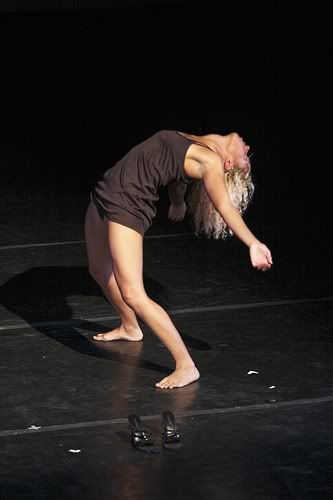
Mechelle Flemming in "Interview for a Date/I Take My Dress Off"
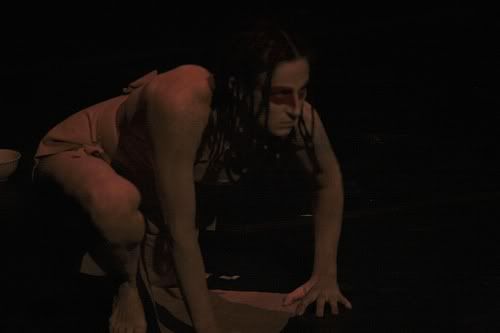
Toni Leago Valle in "I Am Mother"
Sunday, August 16, 2009
Pieced Together and the Tradition of Graffiti
I went to the opening of "Pieced Together" at the Aerosol Warfare Gallery, an exhibit of graffiti art by a variety of Texas artists. This show has been traveling around the country, and Aerosol Warfare is the final stop. Aerosol Warfare is a local gallery devoted to graffiti art and related items.

exterior of Aerosol Warfare

interior of Aerosol Warfare
The pieces on display are small, essentially acrylic versions of the type of large-scale wall pieces that typify the artform.
"Icons" by Reks and Worms

"Extended Release" by Dmise
The opening was not just a passive viewing experience for gallery goers. They had a wall of tiny canvases where you could make your own micro-graffiti piece for $5; it was very popular with the kids (and their parents). They set up a computer-controlled projection system that allowed people to create large scale graffiti pieces projected onto the wall of a building across the street. And they had car-hoods on easels with local artists creating pieces on them.




Even notorious local poster artist Give Up did one. I asked if Give Up was present, but the publicity-shy artist apparently stayed away, lest someone snap his photo. (Someone even asked me if I was Give Up.)
There was an amazing display in the store.

Commemorative Puma sneakers in honor of the late, great Vaughn Bode. This shows that the proprietors of Aerosol Warfare have an awareness of history.
Graffiti art is essentially ephemeral. Illegally put up on walls and concrete barriers, they get rapidly painted over by property owners, city workers, highway departments, transit agencies, etc. This situation would seem inimical to the formation of a tradition. And yet, in pre-literate societies, traditions like this of impermanent artforms (performed music, spoken poetry) have lasted for centuries.

"Michelle" by Sloke
So who was Vaughn Bode and what does he have to do with graffiti? Was he a graffiti artist? Nope. He was a cartoonist whose style informed a lot of the early New York City graffiti artists.

Early writers not only imitated Bode's art style. They included many of his figures in their pieces--Cheech Wizard, the lizards, the "Bode broads", etc.
What were some other non-graffiti sources? I think the psychedelic rock posters of the 60s had their effect. I also think these artists were looking at the artists from Heavy Metal magazine (which started publication in the U.S. in 1977). Specifically artists like Caza and Druillet.

"Supher" by Supher
But these artists who were covering subway cars in NYC in the 1970s have no relationship to an artist like "News" from the Rio Grande Valley--except that a tradition has been established and spread across the U.S. and indeed all over the world.

"Daily News" by News
This artform has been given a certain degree of respect from the fine arts world, analogous with its grudging embrace of comics art by the art world. Art critics respect its folkish traditions and seeming authenticity. But graffiti art has some problems as far as being a part of the art world. It's not a perfect fit. There is a basic truth about graffiti--it is a fundamentally adolescent artform. This is not to say its practitioners are teenagers (although many are), but graffiti, like so many adolescent activities, involves the thrill of petty crime. The colors and cartoonish origins also feel adolescent.
I am not trying to insult the art of graffiti. But I do wonder what it would mean to be an old graffiti artist. Maybe it would look something like this piece.

"Paper in the Wind" by Spain
Saturday, August 15, 2009
Frenetic Fringe Festival -- Weekend 2 Bullets
There's a Tsunami at Your Door
- A short play by Mary Ellen Whitworth.
- A woman about to commit suicide is interrupted by a desperate cable salesman.
- Similar to "Velocity" from last week it its use of a tragedy that happened in the past as the cause of what's happening now.
- But it is a straight-forward narrative, not fractured like "Velocity."
- The acting was slightly raw.
- The play had funny moments despite its grim subject.
- This struck me as fairly innovative.
- Instead of a musical score, there were three short, personal stories by Diana Weeks.
- They were recorded by her and played over loudspeakers.
- She sat stage (she's an older woman, perhaps in her 60s or 70s) while the dancers danced.
- The dancers "interpreted" her story through dance.
- The connection was tenuous, but--
- Both aspects--the story and the dance--were enjoyable.
- It was like, say, riding your bike while listening to your Ipod. You get simultaneous pleasure from both activities.
- A short play by Paul Locklear.
- Slight, farcical story about a hillbilly who comes to L.A. to make it big on the spelling bee circuit.
- He ends up working as a male prostitute.
- A pretty minor piece of work, I'd have to say.
- These were cartoon public service announcements from the 1980s, featuring the G.I. Joe characters telling kids about safety.
- Eric Fensler has recorded new dialogue for them.
- This had the potential to be funny but predictable.
- But Fensler's dialogue (often sounds or made-up foreign languages) was absurd and bizarre.
- It wass still really funny--but not in an easy or obvious way.
- A documentary by Laura Harrison about a soon-to-be ghost town.
- 18 people still live there.
- The National Park Service has bought out most of the folks in town. The intent is to turn this coal mining town into a park along the lines of Mystic Seaport.
- It felt like a typical documentary, one that had neither the power of the old-school documentaries of, say, the Maysles brothers.
- Nor did it use the innovations of Errol Morris or Michael Moore.
- Not that it was bad, just not all that exciting...
- These were the best things I saw all night, indeed the best out of both nights.
- Three solo dances, three solo dancers. They were highly controlled athletes, but each with a kind of way about her that marked them as artists.
- Catalina Molnari is stranded on unsteady looking rectangular boxes. She barely moves as she grips them and attempts to balance.
- Mechelle Fleming is the dancer in this strangely sexual piece.
- In the first part, there is a film of a girl (Valle) being questioned, job-interview style, about why she would be a good girlfriend for the unseen male interviewer.
- The interview itself is forced and calculating, dealing with the value she brings to him as a girlfriend. She is desperate.
- When the interview seems to go wrong, she remembers something.
- She tells him, "Oh, I forgot! I'm good at sex!"
- The whole time, Fleming is sitting on a chair, facing away from the audience.
- She twitches and makes small moves, as if she is constrained and ready to move.
- The movie ends and she starts dancing.
- Her dance struck me as almost tortured. I can hardly describe it in a way that makes sense.
- She seem struck by things outside herself, while engaging with a negotiation with herself.
- She seemed buffeted, struck by forces.
- (But, it should be said, it was clear she was fully in control as a dancer.)
- Finally, she took off her dress.
- And it ended with her standing there in her underwear.
- It it appropriate to mention that she is an astonishingly beautiful woman?
- I regret not having photos of the Fringe Festival, especially for the three dances that Valle choreographed.
- The dancer was Valle.
- Her skin was covered with white, pasty makeup except for her eyes, which were kind of a red racoon mask.
- The dance was done seated, under a soft, dim red spotlight.
- Weirdly enough, I was reminded of the installation by Carlos Runcie-Tanaka called "Tiempo Detenido/No Olvidar." The atmosphere was similar.
- Her movements were constrained by her seated posture.
- But the effect was nonetheless electrifying.
General vibe.
- I sat under a fan, so the lack of AC wasn't too horrible.
- They have us fill out an audience poll that includes demographic info.
- Apparently collecting this info will help them get grants.
- With which they can, say, buy central air-conditioning.
- The seats at Frenetic are only slightly more comfortable than airline seats.
- It seems like a lot of folks are there just to see their friends or family's performance.
- Consequently, a lot of people leave at the intermission.
- Maybe it's not so bad on Saturday and Sunday.
- But one would certainly wish for more support from people who have no personal connection with the performers.
- (Of course, I could be wrong about the audience...)
- I wish I could photograph some of the performances and put them up here.
- That said, there were two photographers with serious-looking photo set-ups in the audience.
- So perhaps if you search the web, you can find some images.
Wednesday, August 12, 2009
The Art of the Offshore Oil Platform
So imagine my surprise when I stumbled across this spooky image:
"Longfall," mixed media, Brook Salzwedel
This was reproduced on the L.A. Times art blog, Culture Monster. I went to artist Brook Salzwedel's site and found this image:

"Unphased," graphite, tape and resin, Brook Salzwedel, 2006
Like it. Perfect art for oilmen!
(Hat tip Art Market Monitor.)
Monday, August 10, 2009
Frenetic Fringe Festival Week 1 bullets
The Festival was not as radical (so far) as what I expected. The pieces were all pretty approachable. I was hoping to be challenged a bit more.
Nearing Velocity
- A short play by Liz Gilbert.
- In fragments, we see all the people who were involved in a car accident at Richmond and Montrose.
- One driver Mallory is now paralyzed, a man, Boyd [sic], in the other car paralyzed with guilt.
- It was a strong opener, with good actors and a play that unfolded in an interesting way.
- I now realize that they bookended the opening night of festival with their two best pieces (of the night).
- It might be my old age, but I sometimes had to strain to hear what the cast members were saying.
- Three women dancing.
- Supposedly about life after death. Music combined with a tape of someone relating a after death experience.
- I have a preconceived notion that all dancers are perfect physical specimens, strong but elegant and beautiful women.
- (See Olga Khokhlova and Lydia Lopokova of the Ballets Russes, for example.)
- But one of these women was a bit on the chunky side.
- People in glass houses should not throw stones, yet this slightly disturbed me!
- The piece was long (it seemed) and by the end, I was in a pleasantly hypnotic state.
- Despite having not understood it at all.
- This short film was mildly amusing, but not particularly "fringe."
- Office Space was a better movie on a similar theme.
- The second play of the evening had a tepidly surreal premise.
- A former circus performer's 12-year-old daughter has hair on her chest.
- The girl, Baby Girl, was actually played by a little girl, who did a hell of a job.
- But the play's point was lost on me--it seemed silly without being all that entertaining.
- This dance piece seemed a little more what I would expect from a dance piece than "Beyond the Sphere."
- At least, so it seemed to my dance-virgin eyes.
- I was impressed but the dancer's skills, but not particularly engaged by them.
- But again, maybe that's just me.
- I don't know what to look for really.
- This was a rather astonishing piece of appropriation.
- Kuliman took bits and pieces of solo music uploaded to YouTube.
- (Often these were music lessons, sometimes they were musicians showing off some of their skills.)
- Out of all these disparate bits of music, he created coherent, multi-instrumental songs.
- The lyrics were often based on spoken-word YouTube videos auto-tuned.
- I recall Thomas McEvilley discussing Hellenistic poetry that consisted of appropriating different poets lines into a single poem.
- McEvilley was making the point that post-modernism's practices of appropriation was an ancient practice.
- But this piece reminded me very specifically of those ancient Greek poems.
- The skill shown in finding and mixing these fragments is astonishing.
- But the results, while perfectly good, are not great.
- This is a complaint that can be made about much OuLiPo-style art.
- i.e., art that puts a really complex, limiting constraint on the artist with the intent of fostering new, creative ways of making art.
- It's amazing, for example, that A Void was written at all.
- The fact that it is also a great novel is a fucking miracle.
- Kuliman's mixtures are totally listenable--but won't stick in my mind.
(There is an art show along-side the Fringe Festival. The artworks are for sale. Stephanie Toppin, for some insane reason, is selling her drawings for $25 apiece. I personally think this is a bargain. I encourage anyone who liked her work at Diverse Works and Box 13 to pick up a drawing or four, before Toppin comes to her senses.) (Toppin, not "Tobbin"--corrected now.)
Thursday, August 6, 2009
Frenetic Fringe Festival Starts Tomorrow
In addition to the the theater, dance and film presentations, there will be an art exhibit. Among the artists is Stephanie Tobbin, who I have blogged about here and here. Here's one of the drawings she will be showing.
Tuesday, August 4, 2009
Art and the Death of a Cat

Read it.











